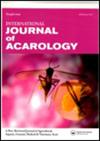印度球形叶螨种群对杀螨剂的敏感性及解毒酶活性研究
IF 1
3区 农林科学
Q3 ENTOMOLOGY
引用次数: 0
摘要
球叶螨(Tetranychus gloveri)是印度喀拉拉邦新近引进的一种螨类,现已成为该邦观赏植物的主要害虫。本研究对印度喀拉拉邦Thrissur地区6个不同商业园艺苗圃的腺属植物上采集的球孢螨(T. gloveri)种群的杀螨抗性和解毒酶活性进行了研究。采用杀虫生物测定法对芬那喹和二敌畏进行杀虫生物测定,对螺虫西芬进行杀虫生物测定以估计LC50。与实验室维持的参考种群相比,野外种群对芬那喹的抗性比为1.66 ~ 14.38倍,对螺虫胺的抗性比为1.06 ~ 27.31倍,对三敌畏的抗性比为1.22 ~ 3.65倍。解毒酶的酶学测定表明,在田间群体中羧酸酯酶活性提高了1.03 ~ 3.52倍,细胞色素P450单加氧酶活性提高了1.01 ~ 2.08倍。然而,谷胱甘肽s -转移酶在不同田间种群耐药发展中的作用不显著。本研究首次记录了革螨对新一代杀螨剂噻虫胺和芬那喹的抗性发展过程,也证实了羧酯酶和细胞色素P450单加氧酶在革螨耐药过程中的重要作用。本文章由计算机程序翻译,如有差异,请以英文原文为准。
Susceptibility to acaricides and detoxifying enzyme activity in Tetranychus gloveri Banks (Acari: Tetranychidae) populations from India
ABSTRACT Tetranychus gloveri, a recently introduced mite species in Kerala, India has now established in the state as a predominant mite pest on ornamental plants. In this study, the status of acaricide resistance and the activity of detoxification enzymes were investigated in the populations of T. gloveri collected on Adenium plants from six different commercial horticultural nurseries of Thrissur district, Kerala, India. Adulticidal bioassays were performed for fenazaquin and dicofol, while nymphicidal bioassays were conducted for spiromesifen to estimate the LC50. The field populations showed resistance ratios in the range of 1.66–14.38-fold for fenazaquin, 1.06–27.31-fold for spiromesifen and 1.22–3.65-fold for dicofol, compared to the laboratory-maintained reference population. Enzyme assays of detoxifying enzymes revealed enhanced activity of carboxylesterase by 1.03–3.52-fold and cytochrome P450 monooxygenase by 1.01–2.08-fold in the field populations. However, the role of glutathione S-transferase in the development of resistance in different field populations was insignificant. The study recorded the development of resistance in the spider mite, T. gloveri to new generation acaricides spiromesifen and fenazaquin for the first time and also confirmed the significant role of the carboxylesterases and cytochrome P450 monooxygenases in imparting resistance in T. gloveri.
求助全文
通过发布文献求助,成功后即可免费获取论文全文。
去求助
来源期刊
CiteScore
2.20
自引率
9.10%
发文量
60
审稿时长
6-12 weeks
期刊介绍:
The International Journal of Acarology has a global readership and publishes original research and review papers on a wide variety of acarological subjects including:
• mite and tick behavior
• biochemistry
• biology
• control
• ecology
• evolution
• morphology
• physiology
• systematics
• taxonomy (single species descriptions are discouraged unless accompanied by additional new information on ecology, biology, systematics, etc.)
All submitted manuscripts are subject to initial appraisal by the Editor. If the English is not of a quality suitable for reviewers, the manuscript will be returned. If found suitable for further consideration, it will be submitted to peer review by independent, anonymous expert referees. All peer review is single blind.

 求助内容:
求助内容: 应助结果提醒方式:
应助结果提醒方式:


